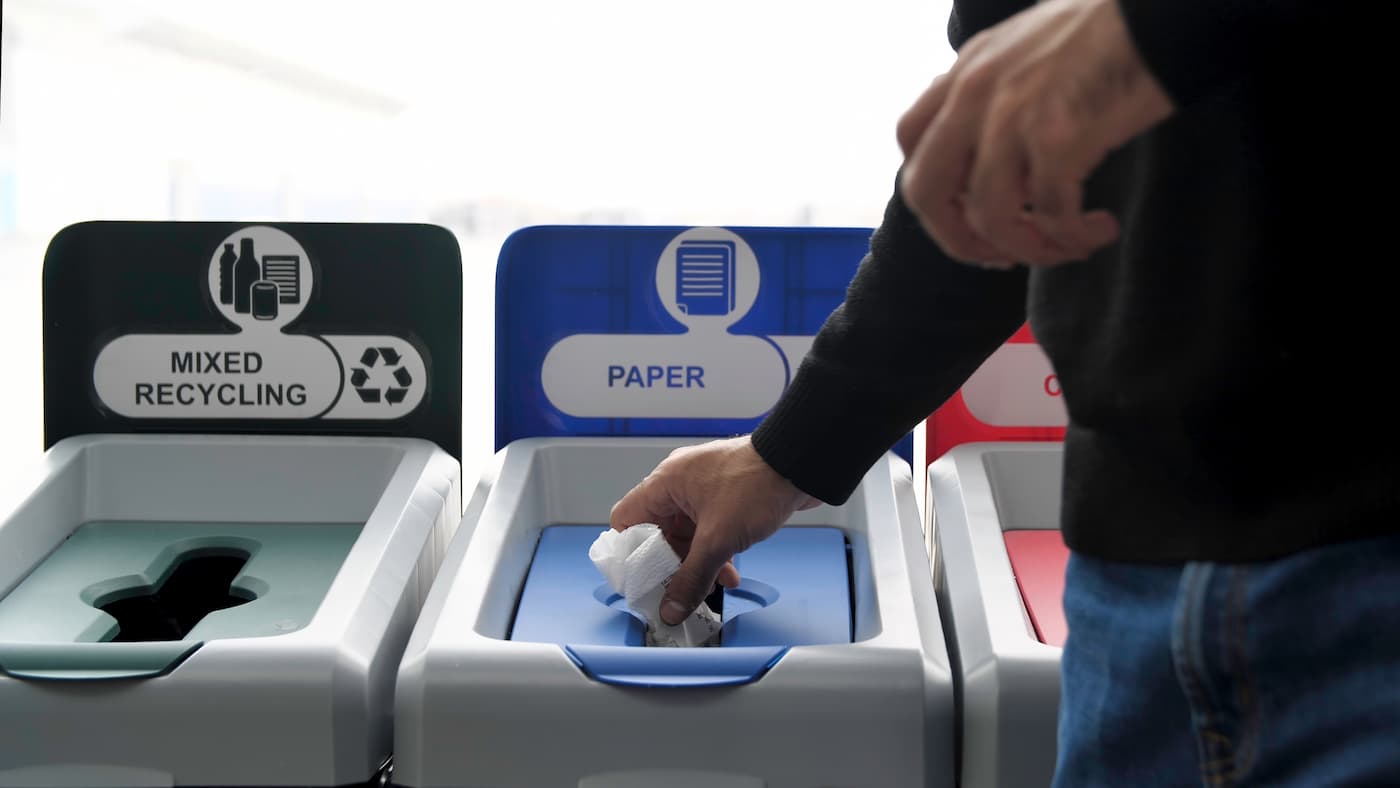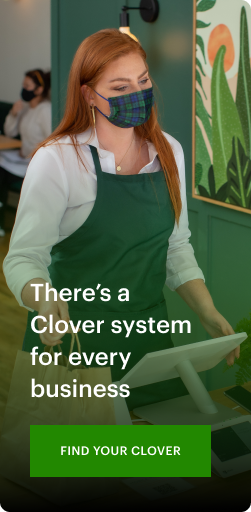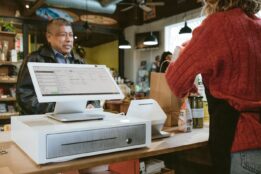Earth Day and the benefits of sustainable business practices
Editorial Team
13 min read
What is Earth Day? The first Earth Day took place on April 22, 1970, organized by Senator Gaylord Nelson and youth activist Denis Hayes after the massive oil spill in Santa Barbara, California, in 1969.
This first Earth Day inspired 20 million Americans (10% of the total U.S. population at the time) to voice their concern about the impacts of 150 years of industrial development that was causing serious human health impacts and environmental degradation.
Why is Earth Day important?
Earth Day also achieved a rare alignment across political, social, and economic sectors, leading to the modern environmental movement. By the end of 1970, the Environmental Protection Agency was created, and various environmental laws, such as the Clean Air Act, the National Environmental Education Act, and the Occupational Safety and Health Act, were passed.
The importance of Earth Day stands in testament to the continued relevance of environmental issues for a sustainable future for our economy and society. Over the past several decades, we have gained an increased insight into the impact of nature on livelihoods. According to the National Centers for Environmental Information, the U.S. has sustained 376 weather and climate disasters in which overall damages exceeded $1 billion since 1980. These events are increasing in frequency, with more than two dozen in 2023 alone, including the deadliest wildfire in the U.S. in more than a century in Hawaii, and the Category 3 Hurricane Idalia in Florida.
When is Earth Day celebrated?
While the official Earth Day event is April 22 every year and features initiatives such as the Great Global Cleanup, businesses can recognize the importance of Earth Day year-round. As climate change affects communities and the economy, businesses and consumers are becoming more sustainability-minded. There are plenty of ways to celebrate Earth Day when you promote sustainability, the importance of environmental protection, and the benefits of going green every day in business.
Businesses going green
Sustainable business practices have been proven to drive sales and improve customer sentiment. According to a study by McKinsey and NielsenIQ:
- Products that make environmental, social, and governance (ESG) claims averaged an 8% higher cumulative growth over the past 5-year period compared to products that didn’t make ESG claims.
- More than 60% of respondents said they’d pay more for goods with sustainable packaging.
- 78% of U.S. consumers say that a sustainable lifestyle matters to them.
Yet, while Forbes reports 90% of executives state that sustainability is important, only 60% of companies have sustainability strategies in place. Small businesses that make sustainability a focus have the potential to gain a competitive advantage. The following are a few foundational areas and small changes to be more sustainable to consider.
Buying locally
This is especially relevant to restaurants, cafés, coffee shops, and food trucks, as well as any business that buys food for their employees. Local, seasonal produce gets you the freshest fruits, veggies, and meats. Buying local also supports your community. It helps you avoid excess packaging and carbon emissions due to transportation.
According to the Maryland Commission on Climate Change, some benefits of sustainable business practices and buying local include:
- Less fuel and energy sources required to transport goods
- Less fuel consumption lessens air pollution and greenhouse gases (GHGs) produced, which lessens impact on climate change
- Locally sourced products are more likely to be fresher, which means reduced spoilage and less food waste
- Sourcing local products leads to better inventory management, which can also lead to less waste and environmental impact
You can work with your local community supported agriculture (CSA) groups or use websites such as Local Harvest to find providers near you. Small businesses can also buy locally from a lot of non-food product and service providers, from furniture to auto repair.
Reducing carbon footprint
The Nature Conservancy states a carbon footprint is the total amount of greenhouse gases, which include methane and carbon dioxide, that a party’s actions generate. For large corporations that require more transportation and bigger facilities, their carbon footprint will typically be much higher compared to a single locally owned business with minimal facilities and production needs. For those interested in how to reduce a carbon footprint for small businesses, online calculators such as Carbonfootprint.com can help you determine yours.
Carbon dioxide (CO2) represents the majority of greenhouse gas emissions. There are also other greenhouse gases that are even more potent and deadly: methane (CH4) and nitrous oxide (N2O) are 84 and 264 times more dangerous than CO2, respectively. A number of solutions have been proposed to manage the levels of greenhouse gases in the atmosphere, including carbon sequestration and carbon offsets.
There’s also a strategy known as CCUS—carbon capture, utilization, and storage. With CCUS, CO2 is either captured or removed from the atmosphere and then stored deep underground or used in business applications. For example, CO2 makes the bubbles in beer or soda, hence the term “carbonated beverage.” It can be used in cement and fuel production. Companies like Climeworks are building direct air capture facilities, while others, like Carbon Craft Design, are finding innovative ways to use black carbon, the particulate matter polluting India’s skies. Cutting-edge collectives, such as Tomorrow’s Air, are engaging tourists and travelers to do their part to remove carbon, as well.
Businesses that sell a product or service that uses, or could help mitigate, CO2 or any other greenhouse gas or pollutant might look into CCUS strategies. Other ways to reduce a business carbon footprint include:
- Install smart sensors within facilities that ensure electricity, heating, and cooling are automatically turned off when unnecessary.
- Ensure that the production of physical goods is closer to the end customer, which reduces transportation-related emissions.
- Install wind or solar-powered applications on-site to replace some or all of electrical needs.
- Buy or rent electric vehicles, rather than gas-consuming vehicles.
- Create a bike-to-work program to motivate employees to try an alternative way to get to the office. Some companies also provide branded bicycles for employee use.
Becoming energy efficient
The way you power your business makes a big difference, both for your bottom line and for the environment. Retail residential electricity rates have increased around 27% in the past 10 years across the country.
Conversely, if your business uses solar energy, you can earn tax credits. Tax credits for solar energy systems include:
- The production tax credit (PTC) is a tax credit based on per kilowatt-hour (kWh) electricity generated by solar and other technologies that qualify for the first 10 years a business is in operation. The tax credit is adjusted each year for inflation.
- The investment tax credit (ITC) is a tax credit for the cost of a solar system that’s installed during that tax year that reduces federal income tax liability for a percentage of the cost.
If you have the option, consider installing solar panels on your building, or talk to your electricity provider to see if they offer wind, solar, or other renewable energy options.
Besides the question of source, there are numerous ways to save energy in your shop, restaurant, or home-based business. These include:
- Replace standard light bulbs with LEDs and old devices with new, energy-efficient models.
- Turn off all electronic devices and equipment at night.
- Set thermostats to lower levels during non-working hours.
- Upgrade appliances and HVAC to energy-efficient models.
- Create an energy management system for a framework for smart energy use.
- Ensure proper maintenance of all energy-using devices, such as changing air filters regularly, to ensure optimal energy use.
You can also make your entire building energy-neutral. Clover’s Sunnyvale HQ is a “net zero energy building,” for example. In addition to reduced energy consumption and costs, a net zero energy building can also help a business hedge against future energy price increases. When the Hampton Inn Bakersfield went solar, it received a 30% federal tax credit and decreased its energy bills by 35%-45%. This guide on net zero buildings provides more information on how to execute such projects.
Using eco-friendly packaging
Whether you’re a restaurant offering curbside pickup or a retailer selling home goods, most product-selling businesses require packaging. Unfortunately, packaging materials such as plastic, paper, polystyrene foam, and cardboard typically go to waste once customers unpack their purchases. Populations in the U.S. and the UK produce more plastic waste per person than any other large nation, The Guardian reports.
There are many ways small businesses can reduce their packaging carbon footprint. These include:
- Use environmentally friendly packaging. Look for suppliers that provide recyclable or compostable boxes and containers.
- Avoid petroleum-based plastics, especially black plastic containers for food.
- Use less. Depending on what you’re delivering or sending, you may not need extra padding or packaging materials. Use the smallest-size packaging available to contain products.
- Consider innovative packaging materials, such as packaging that’s molded to the shape of the product. This can eliminate the need for extra packing material.
- Restaurants can make packaging extras including straws, forks, knives, and condiments by demand only. If a customer does ask for something like utensils or a straw, offer paper or bamboo options.
According to research from McKinsey & Company, 60% to 70% of consumers would pay more for sustainable packaging. By using eco-friendly packaging, you can reduce waste, improve customer sentiment, and attract more eco-conscious customers.
Going paperless
Many businesses use paper for operations functions, including receipts, invoices, notepads, and forms. Going paperless is an immediate, simple, and easy money-saver. Some ways small businesses can reduce paper usage include:
- Go digital whenever possible. Sign up for e-statements with banks, lawyers, and accountants. Choose digital over print subscriptions. Store documents digitally rather than on paper. Go digital for customers, by offering digital rather than paper receipts, for example.
- Think twice before printing. If you do have to print something, print double-sided. If you’re printing internal materials or information, have a stack of used paper ready.
- Place as much internal information online as possible, rather than printing it out. For example, if you have a new hire training guide, upload it to the cloud, and have new employees access it online rather than handing them a paper guide.
When you do buy paper, make sure it’s made of as much recycled wood pulp as possible. By implementing these small changes, you can reap the benefits of reducing paper use, including fewer expenses and more convenience for your company.
Conserving water
Instead of stocking plastic water bottles, install a water filter on the premises. Not only will that save money and prevent empty bottles from ending up in a landfill, but filtered water can also protect the health of employees. That’s because nanoparticles of plastic have been showing up in bottled water.
If you operate a restaurant in a drought-prone area, such as California, Arizona, Nevada, Utah, and New Mexico, you can opt to serve water at the table only on request. Also, choose raw ingredients carefully. Some, especially meat and dairy, take more water to produce than others.
Minimizing waste
Waste management is a critical piece of sustainability efforts. One of the most immediately visible forms of waste is food that’s thrown out. According to RTS:
- The United States is the global leader in food waste.
- Americans throw out nearly 120 billion pounds of food every year. That’s worth more than $218 billion and equates to nearly 40% of the U.S. food supply.
- Food is the single largest component taking up space in U.S. landfills.
- The restaurant industry spends approximately $162 billion every year in costs related to wasted food.
For restaurant owners, there are several ways to decrease food waste costs. These include:
- Design your menu not only with your customers’ tastes and preferences in mind, but also being mindful of the longevity and freshness of ingredients.
- Order inventory efficiently, with a focus on filling demand but minimizing waste.
- Monitor portion sizes. Make them smaller if you see a lot of leftover food coming back from tables.
- Store ingredients at the right temperature and humidity settings to prevent spoilage and extend their shelf life.
- Label food jars, bins, and vats correctly.
- Donate surplus food.
- Work with composting or pelletizing programs to take kitchen food scraps and guest leftovers.
- Encourage guests to take uneaten food home, especially if it’s in their own take-home containers.
Marketing your sustainable business
Incorporating sustainable practices provides a powerful new way to promote your business. According to the National Retail Federation, today’s consumers are increasingly interested in shopping with a sustainability focus. About one-third of customers say they consider the environment nearly all of the time when shopping. The younger the shopper, the more likely they are to be sustainability-minded, with 80% of consumers ages 18 to 34 willing to pay more for sustainable products, compared to two-thirds of all consumers.
Some ways to share your ESG efforts with current and target consumers include:
- Publicize sustainability goals. Public sustainability reports with stated goals and progress can hold a business accountable. For example, Google plans to operate on 24/7 carbon-free energy by 2030. The company updates its current progress on its website. Waste management provider Republic Services publishes an annual sustainability report that includes goals and progress.
- Partner with like-minded companies. When choosing vendors and suppliers, select partners with similar ESG visions. For example, Unilever launched a Partner with Purpose program that promotes partnerships in driving sustainable growth.
- Give back to sustainability-focused organizations. If your business supports philanthropic efforts and monetary donations, choose organizations focused on combating climate change. For example, since 1985, Patagonia has donated 1% of sales to causes dedicated to the restoration and preservation of natural environments.
When you make efforts like these, your business can promote initiatives in marketing materials like social media, email marketing, and in press releases. Share your efforts in person with customers and on your website, as well, so consumers can spread the word about the progress your business is making.
Benefits of sustainable business practices
Another strong reason to make a business green is that customers are increasingly choosing companies that are committed to the environment. Research confirms sustainability matters to consumers, as illustrated below.
- According to Forbes, customers across generations are increasingly willing to spend more for sustainable products. For example, in two years, Gen X consumers’ preference to shop sustainable brands increased by 25%, while their willingness to pay more for sustainable products increased by 42%. This trend is expected to increase as Gen Z becomes a stronger presence among retail shoppers.
- Business News Daily reports there has been a 71% increase in online searches for sustainable goods. Additionally, 72% of consumers report they’re actively purchasing more environmentally friendly products than they did five years ago, while 81% expect to purchase more in the next five years.
- According to Recycling Lives, 81% of people prefer to buy from sustainable businesses, while 90% of people agree it’s vital that society becomes more eco-conscious.
The time, money, and effort it takes to make a business more sustainable can result in many benefits, not just in costs saved and profits gained, but also in brand awareness, goodwill, and customer loyalty. For businesses wondering how to celebrate Earth Day, a 24/7 green business helps protect the environment year-round.
Going green is easy with the right tools
Clover point-of-sale solutions can help businesses become more sustainable. With Clover:
- It’s easy to take payments online and provide customers with more eco-friendly options, such as digital receipts.
- You can move more employee management functions online, and decrease your carbon footprint produced by manual and paper-requiring processes.
- Clover’s inventory management tools help you keep an optimal supply and prevent avoidable product spoilage.
Why wait? Get started with a Clover POS System today to elevate your business.
Related Posts
How to fire an employee: A guide for small businesses
Celebrating female inventors and entrepreneurs during Women’s History Month
Popular Topics
Stay In Touch
Sign up and learn more about Clover.
Thank you for your subscription!
Recent Stories
- How to design a restaurant recipe card–and share it
- Is your business a victim of shrinkflation? Don’t pay more for shorter receipt rolls.
- How to buy a restaurant
Please share your contact information
to access our premium content.
Thank you for sharing your contact information.
Download Now





